Polestar, the automaker owned by Geely, the parent company of Volvo, has evolved to be an electric performance car brand. With that evolution comes a look at what is ahead – in this case the Polestar Precept concept car.
Featuring an interior swathed in sustainable materials and a fresh take on the company’s digital user interface, Precept is more than just a design direction. Polestar says that is,
“a manifesto of things to come; a declaration.”
At the rear is a light bar that descends on each side into vertical aero-wings.Photo courtesy of Polestar
The car signifies a major milestone for Polestar. It emphasizes the brand’s values: pure, progressive, and performance.
“Precept is a declaration, a vision of what Polestar stands for and what makes the brand relevant,” comments Thomas Ingenlath, CEO of Polestar. “The car is a response to the clear challenges our society and industry face. This is not a dream of a distant future, Polestar Precept previews future vehicles and shows how we will apply innovation to minimize our environmental impact.”
The car exhibits what Polestar calls “minimalistic athleticism”. This is, in theory at least, the same design mantra Porsche follows with its 911. The exterior focuses on aerodynamic design rather than ornamentation. The Precept has a 3.1-meter wheelbase, which fits the car’s large battery pack. Its four-door design takes into account a proper amount of head- and legroom in the rear for comfort.
At the front, instead of a traditional grille there’s something the company calls “Polestar SmartZone”. The area houses technology for safety sensors and driver assistance functions. The transparent panel at the front covers two radar sensors and a high-definition camera. A LIDAR pod is mounted on top of the glass roof. The traditional Thor’s Hammer LED headlights from Volvo’s bin evolve in this design with two separate elements.
The concept pays special attention to rear seat head- and legroom.Photo courtesy of Polestar
Above the SmartZone is an integrated front wing while a wide light-blade spans the entire width of the vehicle’s backside, extending into vertical aero-wings.
Side mirrors have been replaced by camera mirrors that are extended into the air on an aerodynamic arm. Cameras like this have been appearing on vehicles for a few years and are already available in Europe. A similar style camera captures all activity at the rear of the car,
eliminating the need for a rearview mirror.
Some of the materials that make up the Precept’s interior include flax-based composites for interior panels and seatbacks. Seat surfaces are 3D-knitted from recycled PET bottles, bolsters and headrests are made from recycled cork vinyl, while carpets are made from reclaimed fishing nets. These elements, combined with digital artistry, define a new premium luxury that surpasses the conventions of leather, wood and chrome.
The digital interfaces of the car build on Volvo and Polestar’s already-established relationship with Google. Running on Android, the portrait-oriented 15-inch center touch screen complements a 12.5-inch driver display. The instrument panel has an array of smart sensors that monitor a driver’s gaze and adjust content on the screens accordingly.
A solid piece of Swedish crystal between the rear seat headrests.
The public will get their first look at the Polestar Precept during the Geneva International Motor Show next month.









